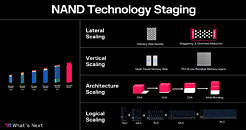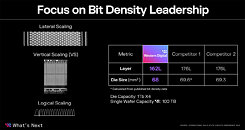TheLostSwede
News Editor
- Joined
- Nov 11, 2004
- Messages
- 18,327 (2.46/day)
- Location
- Sweden
| System Name | Overlord Mk MLI |
|---|---|
| Processor | AMD Ryzen 7 7800X3D |
| Motherboard | Gigabyte X670E Aorus Master |
| Cooling | Noctua NH-D15 SE with offsets |
| Memory | 32GB Team T-Create Expert DDR5 6000 MHz @ CL30-34-34-68 |
| Video Card(s) | Gainward GeForce RTX 4080 Phantom GS |
| Storage | 1TB Solidigm P44 Pro, 2 TB Corsair MP600 Pro, 2TB Kingston KC3000 |
| Display(s) | Acer XV272K LVbmiipruzx 4K@160Hz |
| Case | Fractal Design Torrent Compact |
| Audio Device(s) | Corsair Virtuoso SE |
| Power Supply | be quiet! Pure Power 12 M 850 W |
| Mouse | Logitech G502 Lightspeed |
| Keyboard | Corsair K70 Max |
| Software | Windows 10 Pro |
| Benchmark Scores | https://valid.x86.fr/yfsd9w |
Last week, Micron revealed its NAND flash plans and so did Western Digital during its investors day. The different NAND flash manufacturers use similar, but far from identical ways to manufacture their NAND flash and WD is working together with Kioxia and the two are using a process called bit column stacked or BiCS NAND. This year the two companies will move to its sixth generation of BiCS NAND which is stacking 162-layers of NAND flash. Most of their competitors are already at 176-layer stacks, although WD and Kioxia still deliver the same capacity NAND chips as its competitors. WD claims that their die size is smaller than the competition, which could be an advantage due to more dies per wafer.
In its presentation, WD listed a single wafer capacity of 100 TB, which is an increase from around 70 TB per wafer in 2020. Although it's not something we can verify, WD claims to have the world's best charge trap cell, which the company claims leads to higher performance compared to its competitors. The slide provided by WD claims a 20 MB/s lead of the competition at 60 MB/s vs. 40 MB/s. Although Western Digital and Kioxia claim to have to invest less to increase their capacity, it would appear that they're behind the competition when it comes to the amount of layers they can stack. The two are only planning what they call BiCS+ at over 200-layers for 2024, which is well over a year behind Micron. The roadmap stretches all the way to 2032, when we should apparently be seeing 500-layer NAND flash, assuming everything goes according to plan. The first BiCS+ NAND will be for datacenter products and WD claims that their first product should see a 60 percent increase in transfer speeds, a 15 percent increase in program bandwidth and a 55 percent increase in bit growth per wafer over the current BiCS6 NAND.




View at TechPowerUp Main Site | Source
In its presentation, WD listed a single wafer capacity of 100 TB, which is an increase from around 70 TB per wafer in 2020. Although it's not something we can verify, WD claims to have the world's best charge trap cell, which the company claims leads to higher performance compared to its competitors. The slide provided by WD claims a 20 MB/s lead of the competition at 60 MB/s vs. 40 MB/s. Although Western Digital and Kioxia claim to have to invest less to increase their capacity, it would appear that they're behind the competition when it comes to the amount of layers they can stack. The two are only planning what they call BiCS+ at over 200-layers for 2024, which is well over a year behind Micron. The roadmap stretches all the way to 2032, when we should apparently be seeing 500-layer NAND flash, assuming everything goes according to plan. The first BiCS+ NAND will be for datacenter products and WD claims that their first product should see a 60 percent increase in transfer speeds, a 15 percent increase in program bandwidth and a 55 percent increase in bit growth per wafer over the current BiCS6 NAND.




View at TechPowerUp Main Site | Source





